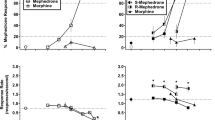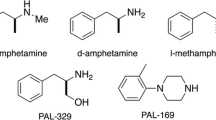Abstract
Rationale: Dopamine plays a major role in the behavioral effects of methamphetamine. Objective: In the present experiments, the effects of different dopaminergic agonists, antagonists, and uptake inhibitors were evaluated in rats discriminating methamphetamine from saline. Methods: In Sprague-Dawley rats trained to discriminate 1.0 mg/kg methamphetamine, i.p., from saline under a fixed-ratio schedule of food delivery, the ability of various dopaminergic agonists and uptake inhibitors to substitute for methamphetamine was evaluated. Subsequently, the ability of various dopaminergic antagonists to block the discriminative-stimulus effects of the training dose of methamphetamine was tested. Results: The dopamine-uptake inhibitors cocaine (10.0 mg/kg), nomifensine (3.0 mg/kg), GBR-12909 (18.0 mg/kg), and bupropion (30.0 mg/kg) fully substituted for the 1.0 mg/kg training dose of methamphetamine. Chloro-APB (SKF-82958), a full agonist at D1 dopamine receptors, produced about 85% methamphetamine-appropriate responding, but the dose required (0.18 mg/kg) markedly decreased rates of responding. Chloro-PB (SKF-81297), another agonist at D1 receptors with a lower intrinsic activity than Chloro-APB, produced only partial generalization (maximum about 55%) at a dose of 1.0 mg/kg. Full substitution for the training dose of methamphetamine was observed with 0.03 mg/kg of the D2 agonist NPA and 0.56 mg/kg of the D3/D2 agonist 7-OH-DPAT. Both NPA and 7-OH-DPAT markedly decreased rates of responding at these doses. The D1 antagonist SCH-23390 (0.056 mg/kg), the D2 antagonist spiperone (0.18 mg/kg), and the mixed D1,D2 antagonist cis-flupenthixol (0.56 mg/kg) all completely blocked the discriminative-stimulus actions of the training dose of methamphetamine. Conclusions: The present findings in rats support previous research findings in other species indicating a major role of dopamine in the discriminative-stimulus effects of methamphetamine. These findings further indicate involvement of dopamine uptake sites as well as D1 and D2 receptors.
Similar content being viewed by others
Author information
Authors and Affiliations
Additional information
Received: 2 July 1999 / Final version: 17 September 1999
Rights and permissions
About this article
Cite this article
Munzar, P., Goldberg, S. Dopaminergic involvement in the discriminative-stimulus effects of methamphetamine in rats. Psychopharmacology 148, 209–216 (2000). https://doi.org/10.1007/s002130050044
Issue Date:
DOI: https://doi.org/10.1007/s002130050044




